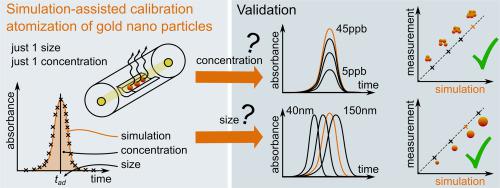Spectrochimica Acta Part B: Atomic Spectroscopy ( IF 3.2 ) Pub Date : 2021-07-03 , DOI: 10.1016/j.sab.2021.106249 Jens Friedland 1 , Anja Brandt 2 , Kerstin Leopold 2 , Robert Güttel 1

|
This study expands the recent experimental investigations, which have shown the possibility to differentiate between nanoparticles (NPs) and metal ions in graphite furnace atomic absorption spectroscopy (GFAAS). Lately, the simultaneous sizing and quantification of Gold NPs was shown experimentally. In this contribution, the experimental results are transferred to a computational model, which enables the possibility to simulate the obtained experimental results. Overfitting is avoided by a minimal number of parameters. With this model, the experimental absorbance signals are extrapolated from one fitting point for changing particle sizes, different analyte concentrations and heating rates. Analyte concentration is predictable over the whole range (5 ppb − 45 ppb) of experimental datapoints. Limits are observed for very small particles (dP < 40 nm) due to the nano effect and for changing heating rates (100 – 750 K s−1) due to model simplicity. For a given temperature program, the precision of the simulated absorbance signals is comparable to experimental ones. Further, the excellent agreement is used to substitute experimental calibration points. The presented method, named simulation-assisted calibration, is evaluated with reference to experimental results. The analysis of the comparison shows eminent agreement for the used concentration range and NPs unaffected by the nano effect. The simulation-assisted calibration is therefore competitive to the experimental calibration. On the basis of typical expenditure of time for the experimental calibration steps, two scenarios of a simulation-assisted calibration are presented, reducing calibration time up to 80%.
中文翻译:

石墨炉原子吸收光谱法中金纳米粒子的雾化:实验结果的建模和模拟探索
这项研究扩展了最近的实验研究,这些研究表明可以在石墨炉原子吸收光谱 (GFAAS) 中区分纳米粒子 (NP) 和金属离子。最近,实验显示了金 NPs 的同步大小和量化。在这个贡献中,实验结果被转移到一个计算模型,这使得模拟获得的实验结果成为可能。通过最少数量的参数避免过拟合。使用该模型,实验吸光度信号从一个拟合点外推,以改变粒径、不同的分析物浓度和加热速率。分析物浓度可在整个实验数据点范围 (5 ppb - 45 ppb) 内预测。对于非常小的颗粒(d P < 40 nm) 由于纳米效应和改变加热速率 (100 – 750 K s -1) 由于模型简单。对于给定的温度程序,模拟吸光度信号的精度与实验信号相当。此外,极好的一致性用于替代实验校准点。所提出的方法,称为模拟辅助校准,参考实验结果进行评估。比较分析表明,所使用的浓度范围和不受纳米效应影响的 NP 具有显着的一致性。因此,模拟辅助校准比实验校准更具竞争力。根据实验校准步骤的典型时间消耗,提出了两种模拟辅助校准方案,将校准时间减少了 80%。











































 京公网安备 11010802027423号
京公网安备 11010802027423号